#quilt history
Explore tagged Tumblr posts
Text
It all started with a reddit post.
No it didn’t. It started when I was 5 and my mom handed me fabric and thread and buttons to keep me busy while she sewed. It started with the Christmas and Easter dresses my grandmother turned out every year without fail. It started with holding tapestries my other grandmother wove. It started with listening to my great-grandmother talk about the quilts city women paid her to finish for them and the rugs she wove on her floor.
I’ve always said that I had textiles in the blood, as a genetic legacy. While only one of the women who came before me called herself an artist (my maternal grandmother) they all chose textiles as their medium.
I made my first quilt in middle school, I think. My grandmother spent decades as purely a garment seamstress, working in a suit store and altering prom dresses on the side, sewing for herself and her loved one. She loved clothes and her huge basement was packed with everything she had made herself. She found herself seeking a new challenge. She’d avoided quilting (possibly because her mother was a quilter and they had a complex relationship) but she decided to give it a go. Her first quilt was a pinwheel, pieced by machine and then hand quilted while she recovered from a knee surgery. She let me quilt a block. I decided I’d make a quilt too, pinwheels the same as her. I didn’t have a book, or a pattern, or the internet and she wasn’t there when I started. I cut my triangles mostly by eye, with scissors, on the living room floor. They were big, maybe 10 inches. I sewed them up and wonky is the kindest word I could give them now, but I felt like a genius. I didn’t know you were supposed to quilt it before binding so I bound it, and pinned the layers together. I even quilted some of the squares. And then I slept with it, pinned together for roughly a decade. It was never fully quilted. It wasn’t long enough to cover both my shoulders and feet, but it was the perfect weight for a summer quilt. I wish I knew what had happened to it.
My second quilt was a whole cloth quilt. I was in grad school. I had the internet, but I didn’t use it. I wanted something the same weight as the first quilt, but long enough to cover my feet. I bound it with satin blanket binding, and quilted a cross, one row up the length through the middle, and one row across the width. I did not read the directions on the batting about how far apart the quilting lines should be. It is now my son’s favorite blanket. It hasn’t fallen apart.
I did a lot more learning (but not enough) and a lot of growing before I tried quilting again. By this time I was a parent and I had learned the value of measuring and rotary cutting. Again I’d make a pinwheel quilt. I learned how to make half square triangles four at a time. My grandmother passed either shortly before or after I started it and I think of her when I work on it. It took me a long time to make the blocks, it took me even longer to put them together. I thread basted it on the floor. I knew enough not to bind before quilting, but I hadn’t yet learned to start in the center of quilt. I worked around the edges and learned even more. I learned that if I quilt too much my hands hurt, I learned that my spouse will sleep under a quilt left on the couch even if it isn’t finished or bound. I eventually learned I should have started in the middle. I started it in 2019, its 2024 and I’m still slowly quilting the blocks. I bound it eventually because the edges were showing a lot of wear (because my spouse has been sleeping under it). Someday it will be done, but it makes me laugh to know that it is serving its purpose regardless, and has been for years.
Another chapter in my quilting story. It was roughly 4am and I was sick. Hopped up on every medication known to humankind and scrolling through my phone. I stumbled across a video of someone stitching fabric wrapped around hexagons together by hand. Half a dozen videos later I was sitting at a computer printing out templates onto cardstock paper and digging through the remains of pandemic mask making fabric. I made a coaster, and then I made a pillow. Before I even made it past the fog of flu I started a hexagon quilt. I didn’t plan, but I kept a somewhat cohesive color story. 900+ hexagons later I had a finished quilt top, it took me about a year, and eventually I chose a backing and used my sewing machine to quilt it together, starting from the center working out, binding at the end. And that is the moment that I finally felt like a quilter.
Its been a while since that night scrolling. I’ve made more quilts, large and small. Not a lot, but enough. I spend a lot of my down time thinking about quilts. When I’m quilting I think about those who came before me, I think about my grandmother’s hands. I think about how intrinsic quilting is to the place I grew up, all the hands that came before my grandmother, and her mother, and the lineage going back through the largely unrecorded history of poor women in rural Appalachia.
Getting back to reddit. The other day I was scrolling through and was struck by this quilt posted on reddit by u/karenosmile.

Classic and yet it is also intrinsically modern.Chaotic and random, but also a repeated pattern of the same simple block. It brought to mind quilts I’d seen while looking through museum collections online (which is a delightful activity for slow afternoons). I went back through my links and the collections again, looking at other examples of quilts that feature that classic ageless block - the half square triangle, also known as the HST. I wanted to know what made that quilt on reddit feel so modern.

The oldest quilt I found in my brief review that felt like it had the same feel as the reddit quilt was this quilt from the 1840s. It is orderly, but combining different sizes of half square triangles. I would not see this as old fashioned if I saw this quilt posted online tomorrow.

The next quilt has been printed out and taped to my wall for months. It was made in 1898 by one Lura, for another Lura. Another lineage. This quilt only has one size of HST and they are orderly arranged to create strong diagonal lines of color across the quilt.

Coming to the 20th century we have another quilt* that uses half square triangles of different sizes, however this one uses blocks of HSTs arranged and combined with large white triangles to form yet another larger HST.
Ultimately I think the thing that sets the original reddit quilt apart is the scattered variety of block sizes and the seemingly random placement of the blocks. The varying size abandons the strict repetition of the museum pieces while maintaining the simple geometry of the block itself.
*Link may not work as it is from Jstor
#quilting#hand quilting#historical quilt#quilt history#half square triangles#hst#classic quilt blocks
15 notes
·
View notes
Text
8 notes
·
View notes
Text

5,000 years ago, the Chinese learned to make breathable, lightweight and comfortable quilts from silkworm silk. Thess videos shows how they are made. It's very fascinating!

youtube
#crafts#gifts#decor#sewing#quilting#briar rose quilts#bedding#shopping#quilters of tumblr#quilts#quilt#silk#silk quilt#chinese#history#quilt history#blankets#silk worm#textile art#fabric#fabric art#Youtube
4 notes
·
View notes
Text
Happy birthday, Duane.

#Duane Kearns Puryear#HIV/AIDS#queer history#AIDS Memorial Quilt#Duane died in 1991#He’d be 59 this year
37K notes
·
View notes
Text
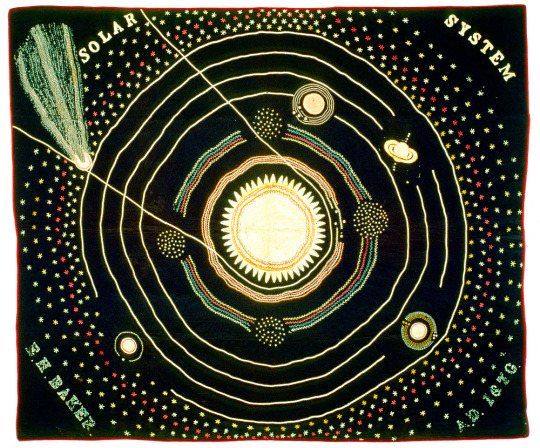
In the autumn of 1883, a paper in the nation's capital reported that "an Iowa woman has spent 7 years embroidering the solar system on a quilt" — to teach astronomy in an era when women could not attend college. Her story.
#Women's History Month#women's history#astronomy#craft#quilting#space#science#science and technology#history and literature#culture and society
6K notes
·
View notes
Text






Great example of everyday noragi (work clothes, worn by farmers for ex.) from Taisho period. Note the makisode sleeve shape, offering freedom of mouvement!
You can see the close-up of the weave, made from asa (bast-fiber like hemp or linen) and kamiyori (twisted paper thread). Despite its "rugged" materials, weave is delicately interlocked with regular black stripes.
The coat also presents geometrical sashiko (white quilting), both reinforcing easily worn areas (collar, hems, inner center back), and decorating the garment.
PSA for writers: please please please don't put characters doing manual labour in "silk" kimono. I'll be forever grateful ;)
#japan#fashion#kimono#fashion history#noragi#work clothes#farmers#asa#hemp#linen#kamiyori#paper thread#sashiko#Japanese quilting#taisho period#着物
1K notes
·
View notes
Text

butch/twink
2024
quilted white scrap fabric text on a black shirt that reads “BUTCH TWINK”
#for dykes and fags alike#inspired by a tweet lol#also i want to wear this to a queer event on friday#twospirit#indigiqueer#my work#textiles#quilting#indigenous art#queer art#métis art#art#contemporary art#contemporary fibre#textile art#fibre art#queer history#butch art#butch#lesbian#transsexual#transgender#transgender art
2K notes
·
View notes
Text
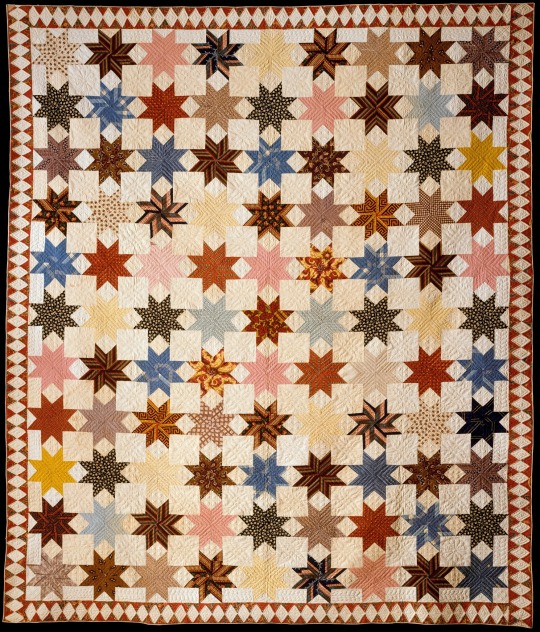
Rebecca Davis (American)
Star of Lemoyne Quilt
ca. 1846
#Rebecca Davis#quilts#quiltblr#quilting#quilt maker#textiles#american art#art history#aesthetictumblr#tumblraesthetic#tumblrpic#tumblrstyle#tumblr art#tumblrpictures#tumblrposts#women artists#beauty#quilters of tumblr#handmade quilt#quilt#quilt making
3K notes
·
View notes
Text
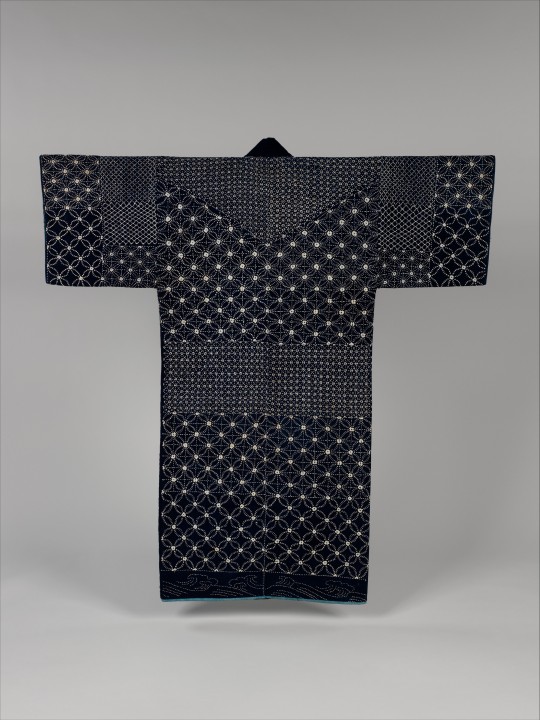

Sashiko Jacket
1850-1899 (Meiji Era)
Japan
Sashiko is a quilting technique that uses a running stitch to reinforce and prolong the life of a textile or to join together recycled pieces of cloth into a new garment. Japanese farmers used the technique to create warmer and more durable fabrics, and decorative sashiko stitching developed from this practical function. This robe’s embroidered design is dominated by three variations on the pattern of interlocking circles, called shippō-tsunagi. The bottom band features a design of waves.
The MET (Accession Number: 67.172.1)
#sashiko#fashion history#historical fashion#japanese fashion#non western fashion#japanese art#19th century#meiji era#quilting#japan#blue#off white#cotton#robe#jacket#1850s#1860s#1870s#1880s#1890s#the met
2K notes
·
View notes
Text
Broken Dishes
I enjoyed the rambling post about personal quilt history and I saw another pattern in my meanderings yesterday that I wanted to connect back through history, albeit more briefly (in theory.

The Postcards from Sweden quilt is currently hugely popular (and free!) Designer Kelly Liddle was inspired by a simple postcard found in an IKEA store. The pattern is essentially the classic quilt block called broken dishes, which is made up of our friends the half square triangle. The Postcards from Sweden abandons more traditional use of light and dark contrasts in favor of bright fabrics which have a lot of visual interest but little contrast.*

The maker of this Broken Dishes quilt made with silk fabrics around 1920 uses fabrics with a similar tone across the center of the quilt and it has deep plush quilting that almost succeeds as disguising the classic HST. The maker likely began in the center of the quilt, and added blocks around the sides later on, perhaps due to miscalculating the size of the finished piece. The final result is opulent and I would LOVE to run my hands over the contrasting texture of the silk and the quilting lines.

This cotton version of the same block incorporates more contrast, but using dark where other quilters might use the light. Made around 1930 it feels very modern with its deep black border and vibrant hues.

This undated broken dishes quilt has the same wide border, but a cooler color pallete combined with a larger block size makes for a more soothing experience for the viewer.
*One way to look at contrast in quilts or in other textile arts is to convert an image to black and white.
15 notes
·
View notes
Text
12 notes
·
View notes
Text

In Paintings and Quilts, Stephen Towns Spotlights Black Leisure in the Jim Crow South
189 notes
·
View notes
Text




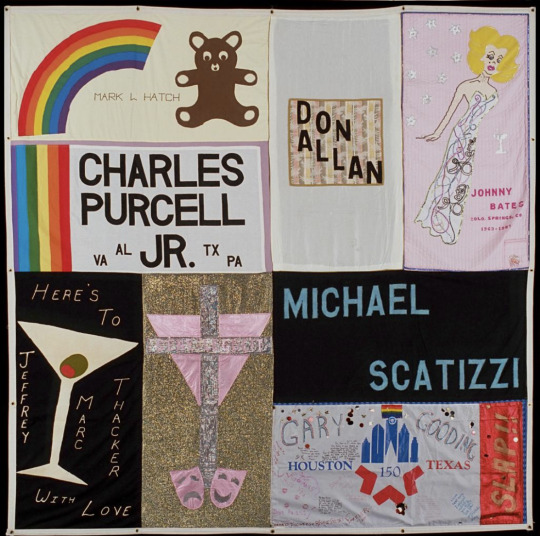
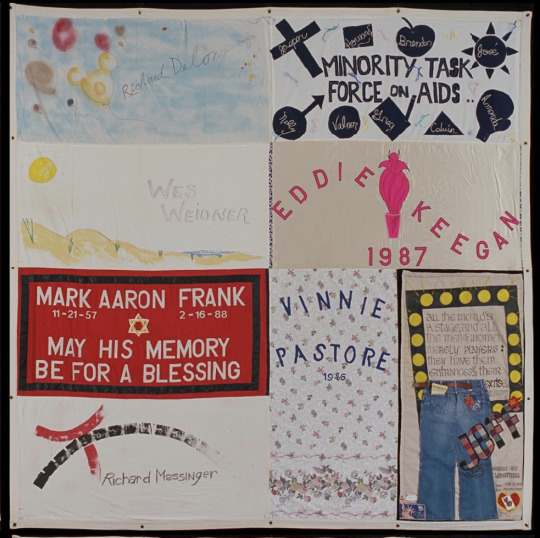
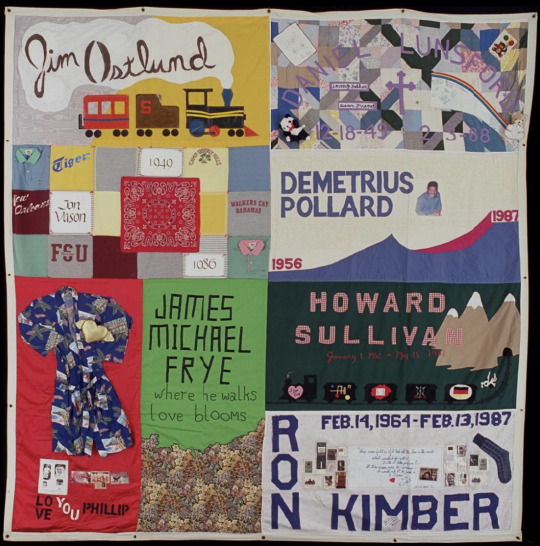
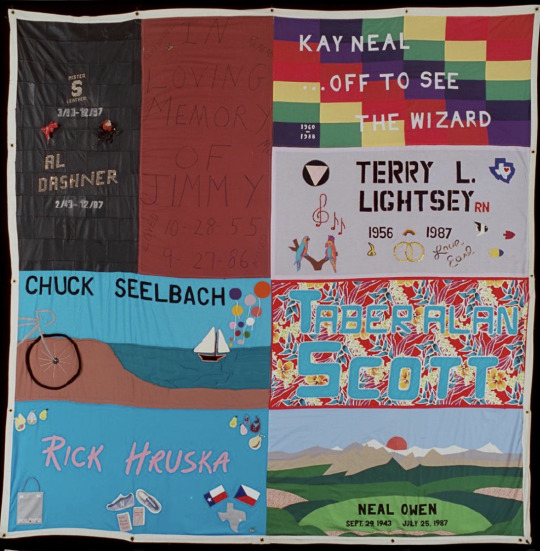

“Still loved."
AIDS QUILT SERIES | VIEW THE QUILT
#*aq#aids quilt#AIDS#HIV AIDS#aids memorial#aids activism#act up#world aids day#lgbtq#lgbt history#queer history#thank you to the person who found my tag.#and reblogged them all today.#it inspired me to make a new post.#they were so loved !#and they are still loved !#mine.
125 notes
·
View notes
Text


couldn't find this posted elsewhere so wanted to highlight this excellent article about Coretta Scott King's work & legacy, especially in loving Black queer people & working for queer liberation
image description: two screenshots from the Autostraddle article "How Coretta Scott King Leveraged MLK's Legacy to Fight for Gay Rights." the text reads:
In the mid-1980s, when President Ronald Reagan wouldn’t even acknowledge the disease, Scott King – with the help of her assistant Lynn Cothren, an openly gay man — used the King Center to create a welcoming environment for the LGBT community, especially queer black people who were suffering in the middle of a generational genocide from HIV/AIDS. After the death of a close gay friend, she hosted a day of memorial at the Center and encouraged participants to sew stitches on a panel that would become part of the AIDS memorial quilt.
On March 31st 1998, at the 25th Anniversary luncheon for the Lambda Legal Defense and Education Fund, King spoke out against strands of conservatism in black communities that had kept some members reluctant to join the gay rights movement. She stated, “I still hear people say that I should not be talking about the rights of lesbian and gay people and I should stick to the issue of racial justice… but I hasten to remind that Martin Luther King, Jr. said, ‘Injustice anywhere is a threat to justice everywhere.’ I appeal to everyone who believes in Martin Luther King, Jr.’s dream to make room at the table of brotherhood and sisterhood for lesbian and gay people.”
end image description.
#coretta scott king#queer history#black history#collective liberation#intersectionality#aids#hiv/aids#aids quilt#civil rights movement#lynn cothren#martin luther king jr#mlk jr#mlk day#mlk jr day#mac.txt#image described#misogynoir#homophobia#mac’s bookshelf
108 notes
·
View notes
Text
This is a dumb idea and way too long but…
Okay, so as a quilter I’ve had a lot of time to sit and think. I love hand sewing and the history of creating things from nothing and using every last scrap of fabric. Another thing I enjoy is the history of fashion, fabric and of course quilts. Which made me come across a museum page about war-time quilts. Specifically the ones made in the 1800s. These quilts are made up from soldier uniforms and that got me thinking about the uniforms of L’Manburg.
The fabric I imagine would most likely be wool or linen. These fabrics were the cheaper, and easier to produce in history for most people. Wool would most likely be their coats, felted hats, while linen would be their shirts, pants and such. Wool is still expensive but was historically cheaper than cotton and warmer. They’d have a lot of uniforms for a lot of soldiers. Maybe two for each along with wool blankets, and other similar items.
What if, during Pogtopia, soldiers were cutting up their old uniforms to make blankets and quick, basic quilts to stay warm in the ravines? What if they were dismantling their last bits and pieces of L’Manburg to survive the cold, damp weather in the ravine? What if as the soldiers loyal to Wilbur were teaching Tommy how to sew? Trying to protect him from Wilbur’s declining mental state? What if Tommy bonded over this love of sewing but thought he lost it in exile?
Maybe Phil tried to teach Wilbur when he was young but he was too easily frustrated by the process. Seeing Tommy sew in Pogtopia just brings Wilbur bad memories. Maybe he yells and lashes out at Tommy, making Tommy hide his passion, suppressing it.
Following this line of thought I could imagine Phil and Technoblade also being the sort to sew, knit, and quilt. The area they’re in is extremely cold. Wool would be easy to produce in the summer or bought from villages. During snow storms and blizzards I imagine them sitting by the fire talking and sewing together.
It’s not until Tommy escapes his exile that he sees Technoblade and Phil sewing. He slowly picks up sewing again, using it to heal and begins adding embroidery to his quilts. He sits on the floor with Technoblade and Phil learning how to sew and make something just for himself.
It takes him a long time to heal. Quilting is a slow process with a lot of mistakes, backpedaling, undoing and redoing things that seem pointless in the moment until he looks at his hard work and realizes he’s grown. Sure, he drops it for a while but he always comes back to it when he feels like he wants to make something nice for himself and his friends.
One day, far from the SMP with Tubbo and his sheep Mareep, he finds himself quilting again. It turns old, painful memories into something that warms and comforts Tubbo and himself.
Update: There is now art. [Link]
#Text#tommyinnit#philza#Technoblade#long ramble#dsmp#headcanon#Edit: the drawing is happening#This may make zero sense to people idk#i have a lot of thoughts#I could literally over explain the messages of quilts and the history of using them in secret messages and stuff#my art
74 notes
·
View notes
Text

The Advocate, 1988. From cartoonist Gerard Donelan.
90 notes
·
View notes